Management Report: Functions, Culture, Communication Mistakes at Tesco
VerifiedAdded on 2020/07/22
|9
|2102
|47
Report
AI Summary
This report delves into the core functions of management, including planning, organizing, leading, and controlling, within the context of a Tesco case study. It examines the importance of these functions in achieving organizational goals and objectives. The report further explores the nature of management culture, emphasizing how beliefs, values, and norms impact employee behavior and overall business success. It uses the 'culture web' framework to analyze Tesco's organizational structure, control systems, and power dynamics. Finally, the report identifies common communication mistakes made by managers, such as ineffective language use, one-way communication, and failure to inform employees about strategies, highlighting their negative consequences and providing potential solutions. The report concludes by summarizing the key takeaways and emphasizing the critical role of effective management in driving organizational performance and achieving desired outcomes.
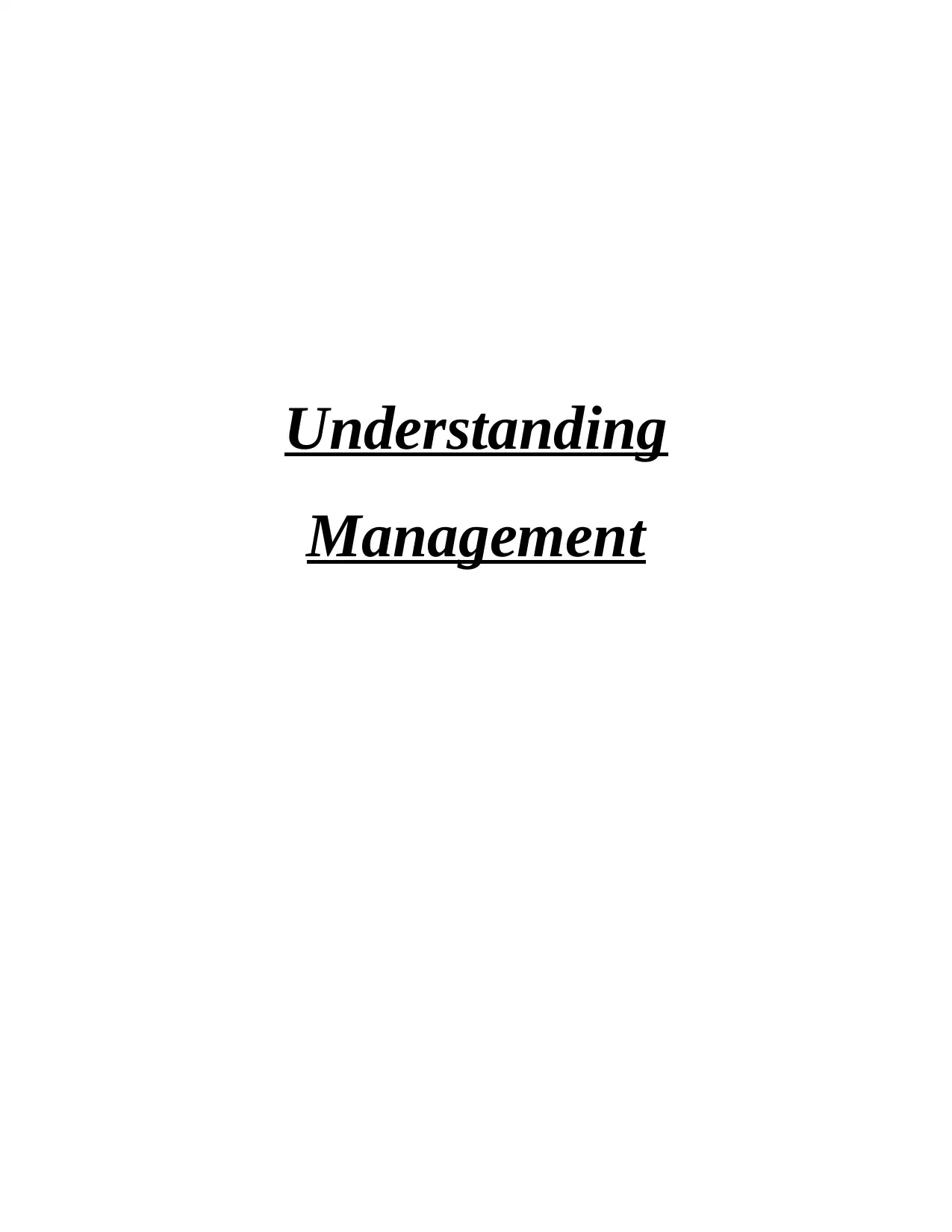
Understanding
Management
Management
Paraphrase This Document
Need a fresh take? Get an instant paraphrase of this document with our AI Paraphraser
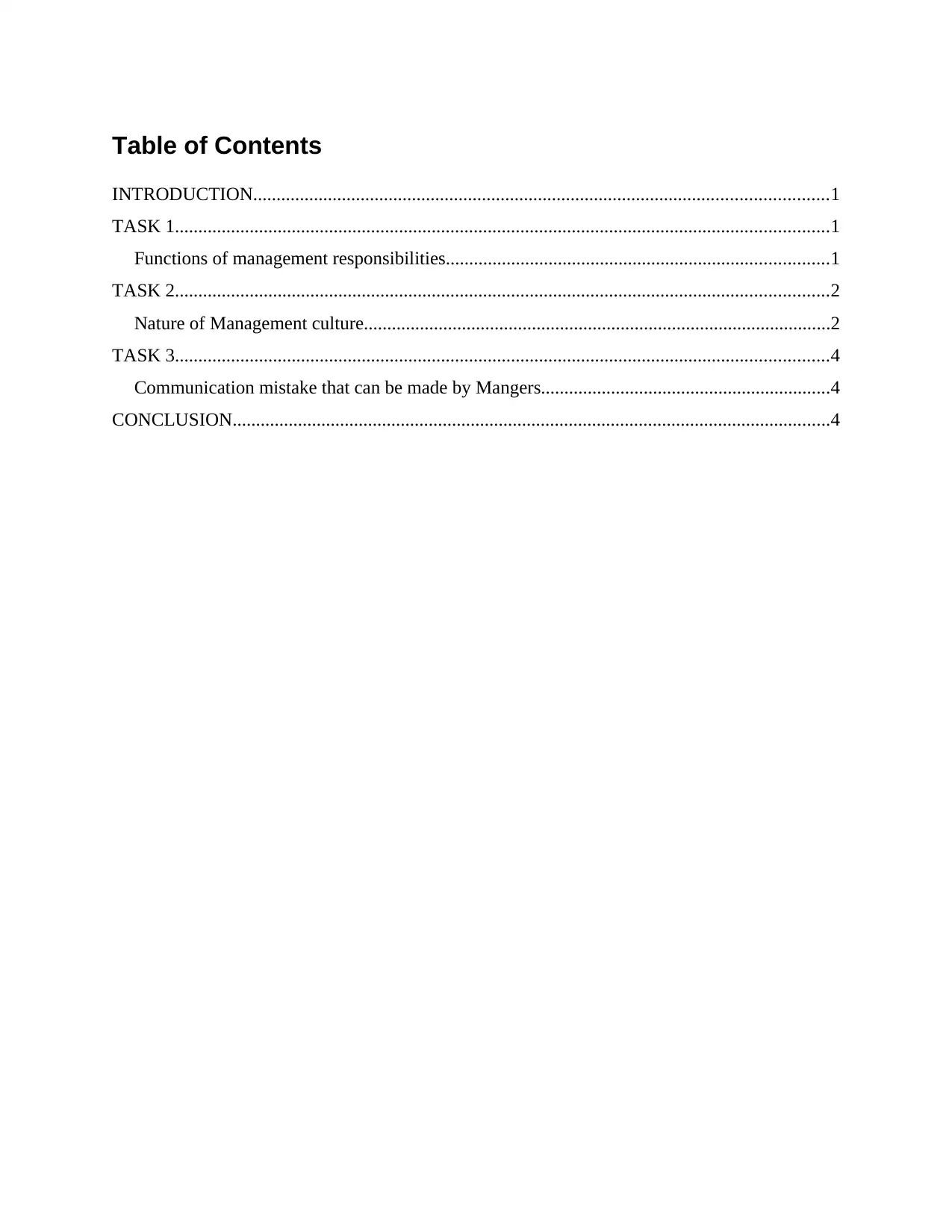
Table of Contents
INTRODUCTION...........................................................................................................................1
TASK 1............................................................................................................................................1
Functions of management responsibilities..................................................................................1
TASK 2............................................................................................................................................2
Nature of Management culture....................................................................................................2
TASK 3............................................................................................................................................4
Communication mistake that can be made by Mangers..............................................................4
CONCLUSION................................................................................................................................4
INTRODUCTION...........................................................................................................................1
TASK 1............................................................................................................................................1
Functions of management responsibilities..................................................................................1
TASK 2............................................................................................................................................2
Nature of Management culture....................................................................................................2
TASK 3............................................................................................................................................4
Communication mistake that can be made by Mangers..............................................................4
CONCLUSION................................................................................................................................4
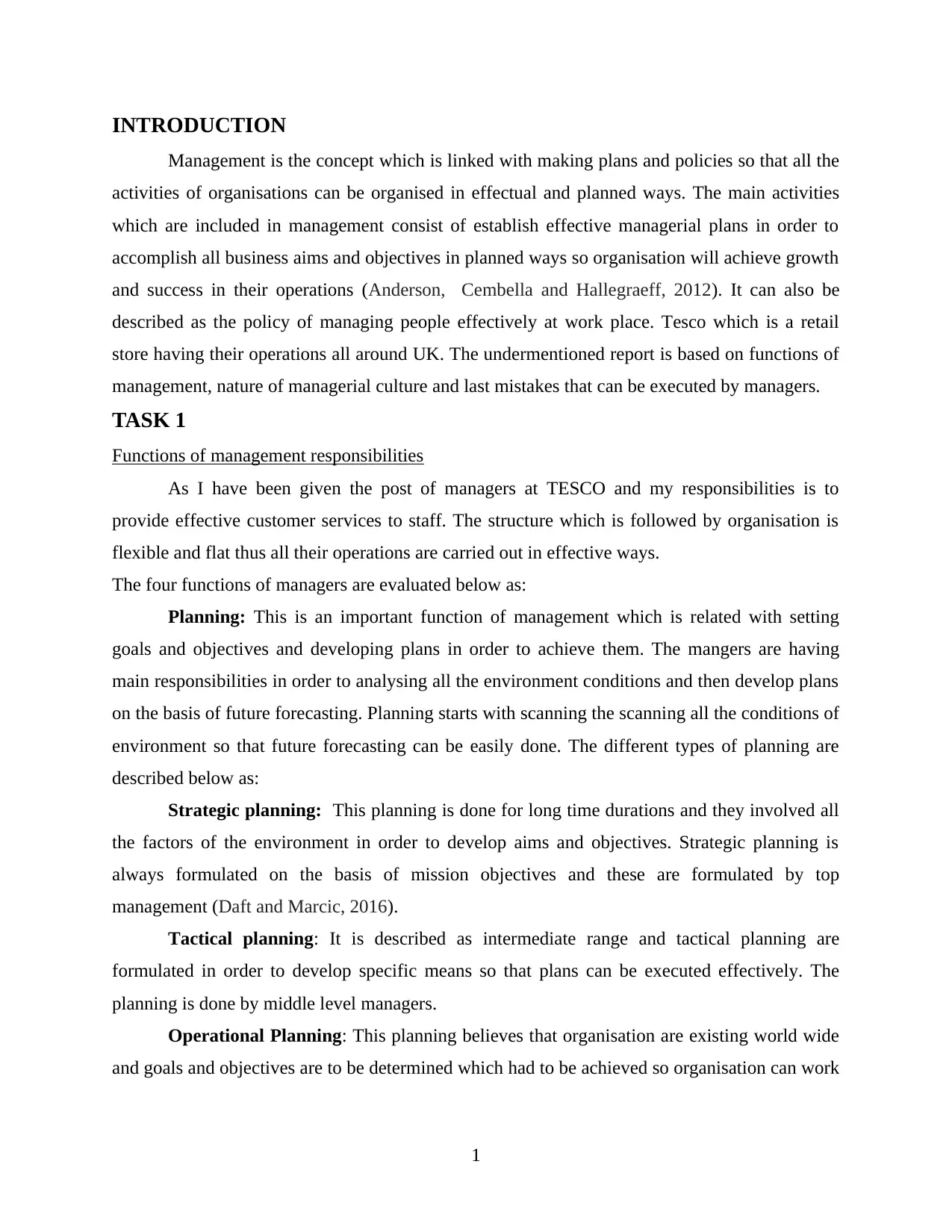
INTRODUCTION
Management is the concept which is linked with making plans and policies so that all the
activities of organisations can be organised in effectual and planned ways. The main activities
which are included in management consist of establish effective managerial plans in order to
accomplish all business aims and objectives in planned ways so organisation will achieve growth
and success in their operations (Anderson, Cembella and Hallegraeff, 2012). It can also be
described as the policy of managing people effectively at work place. Tesco which is a retail
store having their operations all around UK. The undermentioned report is based on functions of
management, nature of managerial culture and last mistakes that can be executed by managers.
TASK 1
Functions of management responsibilities
As I have been given the post of managers at TESCO and my responsibilities is to
provide effective customer services to staff. The structure which is followed by organisation is
flexible and flat thus all their operations are carried out in effective ways.
The four functions of managers are evaluated below as:
Planning: This is an important function of management which is related with setting
goals and objectives and developing plans in order to achieve them. The mangers are having
main responsibilities in order to analysing all the environment conditions and then develop plans
on the basis of future forecasting. Planning starts with scanning the scanning all the conditions of
environment so that future forecasting can be easily done. The different types of planning are
described below as:
Strategic planning: This planning is done for long time durations and they involved all
the factors of the environment in order to develop aims and objectives. Strategic planning is
always formulated on the basis of mission objectives and these are formulated by top
management (Daft and Marcic, 2016).
Tactical planning: It is described as intermediate range and tactical planning are
formulated in order to develop specific means so that plans can be executed effectively. The
planning is done by middle level managers.
Operational Planning: This planning believes that organisation are existing world wide
and goals and objectives are to be determined which had to be achieved so organisation can work
1
Management is the concept which is linked with making plans and policies so that all the
activities of organisations can be organised in effectual and planned ways. The main activities
which are included in management consist of establish effective managerial plans in order to
accomplish all business aims and objectives in planned ways so organisation will achieve growth
and success in their operations (Anderson, Cembella and Hallegraeff, 2012). It can also be
described as the policy of managing people effectively at work place. Tesco which is a retail
store having their operations all around UK. The undermentioned report is based on functions of
management, nature of managerial culture and last mistakes that can be executed by managers.
TASK 1
Functions of management responsibilities
As I have been given the post of managers at TESCO and my responsibilities is to
provide effective customer services to staff. The structure which is followed by organisation is
flexible and flat thus all their operations are carried out in effective ways.
The four functions of managers are evaluated below as:
Planning: This is an important function of management which is related with setting
goals and objectives and developing plans in order to achieve them. The mangers are having
main responsibilities in order to analysing all the environment conditions and then develop plans
on the basis of future forecasting. Planning starts with scanning the scanning all the conditions of
environment so that future forecasting can be easily done. The different types of planning are
described below as:
Strategic planning: This planning is done for long time durations and they involved all
the factors of the environment in order to develop aims and objectives. Strategic planning is
always formulated on the basis of mission objectives and these are formulated by top
management (Daft and Marcic, 2016).
Tactical planning: It is described as intermediate range and tactical planning are
formulated in order to develop specific means so that plans can be executed effectively. The
planning is done by middle level managers.
Operational Planning: This planning believes that organisation are existing world wide
and goals and objectives are to be determined which had to be achieved so organisation can work
1
⊘ This is a preview!⊘
Do you want full access?
Subscribe today to unlock all pages.

Trusted by 1+ million students worldwide
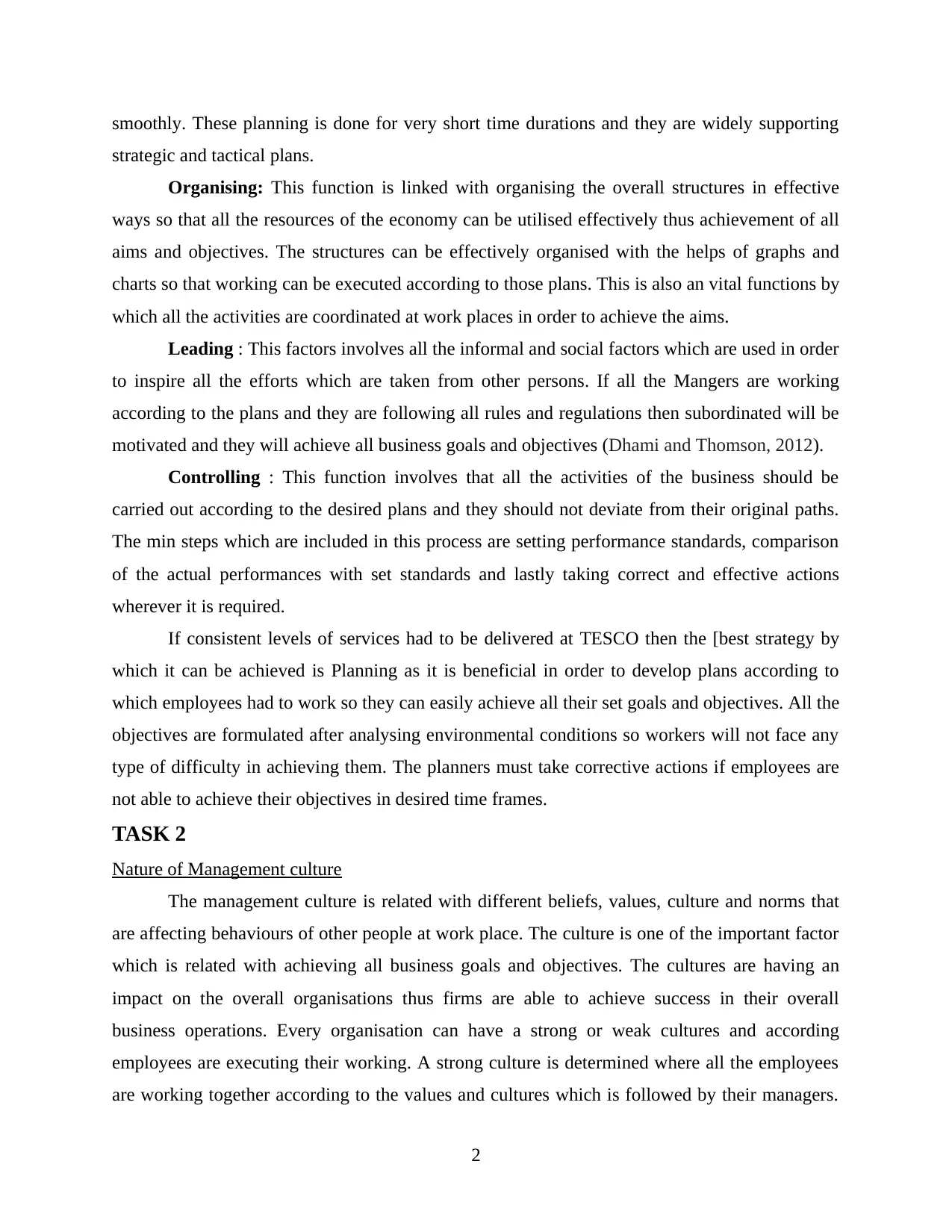
smoothly. These planning is done for very short time durations and they are widely supporting
strategic and tactical plans.
Organising: This function is linked with organising the overall structures in effective
ways so that all the resources of the economy can be utilised effectively thus achievement of all
aims and objectives. The structures can be effectively organised with the helps of graphs and
charts so that working can be executed according to those plans. This is also an vital functions by
which all the activities are coordinated at work places in order to achieve the aims.
Leading : This factors involves all the informal and social factors which are used in order
to inspire all the efforts which are taken from other persons. If all the Mangers are working
according to the plans and they are following all rules and regulations then subordinated will be
motivated and they will achieve all business goals and objectives (Dhami and Thomson, 2012).
Controlling : This function involves that all the activities of the business should be
carried out according to the desired plans and they should not deviate from their original paths.
The min steps which are included in this process are setting performance standards, comparison
of the actual performances with set standards and lastly taking correct and effective actions
wherever it is required.
If consistent levels of services had to be delivered at TESCO then the [best strategy by
which it can be achieved is Planning as it is beneficial in order to develop plans according to
which employees had to work so they can easily achieve all their set goals and objectives. All the
objectives are formulated after analysing environmental conditions so workers will not face any
type of difficulty in achieving them. The planners must take corrective actions if employees are
not able to achieve their objectives in desired time frames.
TASK 2
Nature of Management culture
The management culture is related with different beliefs, values, culture and norms that
are affecting behaviours of other people at work place. The culture is one of the important factor
which is related with achieving all business goals and objectives. The cultures are having an
impact on the overall organisations thus firms are able to achieve success in their overall
business operations. Every organisation can have a strong or weak cultures and according
employees are executing their working. A strong culture is determined where all the employees
are working together according to the values and cultures which is followed by their managers.
2
strategic and tactical plans.
Organising: This function is linked with organising the overall structures in effective
ways so that all the resources of the economy can be utilised effectively thus achievement of all
aims and objectives. The structures can be effectively organised with the helps of graphs and
charts so that working can be executed according to those plans. This is also an vital functions by
which all the activities are coordinated at work places in order to achieve the aims.
Leading : This factors involves all the informal and social factors which are used in order
to inspire all the efforts which are taken from other persons. If all the Mangers are working
according to the plans and they are following all rules and regulations then subordinated will be
motivated and they will achieve all business goals and objectives (Dhami and Thomson, 2012).
Controlling : This function involves that all the activities of the business should be
carried out according to the desired plans and they should not deviate from their original paths.
The min steps which are included in this process are setting performance standards, comparison
of the actual performances with set standards and lastly taking correct and effective actions
wherever it is required.
If consistent levels of services had to be delivered at TESCO then the [best strategy by
which it can be achieved is Planning as it is beneficial in order to develop plans according to
which employees had to work so they can easily achieve all their set goals and objectives. All the
objectives are formulated after analysing environmental conditions so workers will not face any
type of difficulty in achieving them. The planners must take corrective actions if employees are
not able to achieve their objectives in desired time frames.
TASK 2
Nature of Management culture
The management culture is related with different beliefs, values, culture and norms that
are affecting behaviours of other people at work place. The culture is one of the important factor
which is related with achieving all business goals and objectives. The cultures are having an
impact on the overall organisations thus firms are able to achieve success in their overall
business operations. Every organisation can have a strong or weak cultures and according
employees are executing their working. A strong culture is determined where all the employees
are working together according to the values and cultures which is followed by their managers.
2
Paraphrase This Document
Need a fresh take? Get an instant paraphrase of this document with our AI Paraphraser
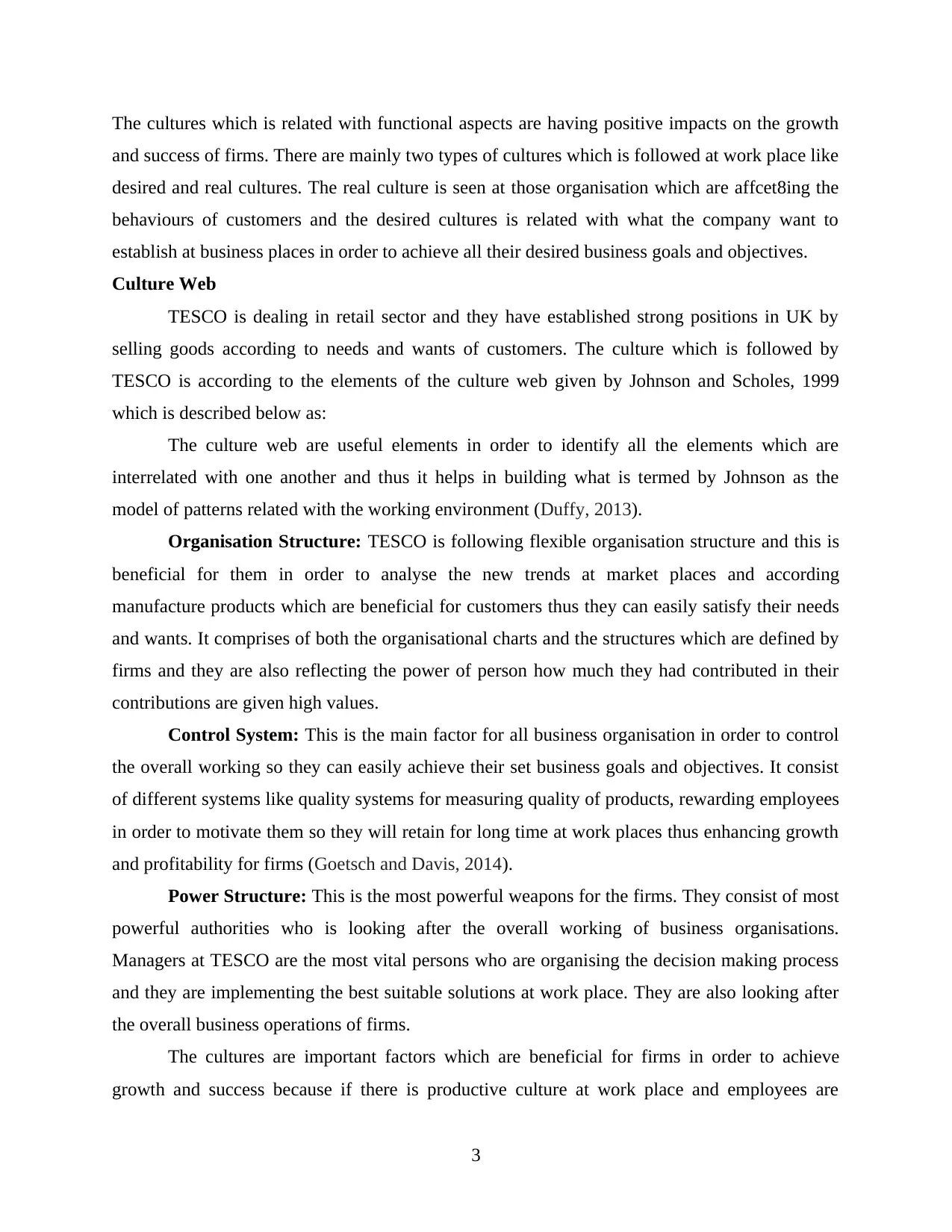
The cultures which is related with functional aspects are having positive impacts on the growth
and success of firms. There are mainly two types of cultures which is followed at work place like
desired and real cultures. The real culture is seen at those organisation which are affcet8ing the
behaviours of customers and the desired cultures is related with what the company want to
establish at business places in order to achieve all their desired business goals and objectives.
Culture Web
TESCO is dealing in retail sector and they have established strong positions in UK by
selling goods according to needs and wants of customers. The culture which is followed by
TESCO is according to the elements of the culture web given by Johnson and Scholes, 1999
which is described below as:
The culture web are useful elements in order to identify all the elements which are
interrelated with one another and thus it helps in building what is termed by Johnson as the
model of patterns related with the working environment (Duffy, 2013).
Organisation Structure: TESCO is following flexible organisation structure and this is
beneficial for them in order to analyse the new trends at market places and according
manufacture products which are beneficial for customers thus they can easily satisfy their needs
and wants. It comprises of both the organisational charts and the structures which are defined by
firms and they are also reflecting the power of person how much they had contributed in their
contributions are given high values.
Control System: This is the main factor for all business organisation in order to control
the overall working so they can easily achieve their set business goals and objectives. It consist
of different systems like quality systems for measuring quality of products, rewarding employees
in order to motivate them so they will retain for long time at work places thus enhancing growth
and profitability for firms (Goetsch and Davis, 2014).
Power Structure: This is the most powerful weapons for the firms. They consist of most
powerful authorities who is looking after the overall working of business organisations.
Managers at TESCO are the most vital persons who are organising the decision making process
and they are implementing the best suitable solutions at work place. They are also looking after
the overall business operations of firms.
The cultures are important factors which are beneficial for firms in order to achieve
growth and success because if there is productive culture at work place and employees are
3
and success of firms. There are mainly two types of cultures which is followed at work place like
desired and real cultures. The real culture is seen at those organisation which are affcet8ing the
behaviours of customers and the desired cultures is related with what the company want to
establish at business places in order to achieve all their desired business goals and objectives.
Culture Web
TESCO is dealing in retail sector and they have established strong positions in UK by
selling goods according to needs and wants of customers. The culture which is followed by
TESCO is according to the elements of the culture web given by Johnson and Scholes, 1999
which is described below as:
The culture web are useful elements in order to identify all the elements which are
interrelated with one another and thus it helps in building what is termed by Johnson as the
model of patterns related with the working environment (Duffy, 2013).
Organisation Structure: TESCO is following flexible organisation structure and this is
beneficial for them in order to analyse the new trends at market places and according
manufacture products which are beneficial for customers thus they can easily satisfy their needs
and wants. It comprises of both the organisational charts and the structures which are defined by
firms and they are also reflecting the power of person how much they had contributed in their
contributions are given high values.
Control System: This is the main factor for all business organisation in order to control
the overall working so they can easily achieve their set business goals and objectives. It consist
of different systems like quality systems for measuring quality of products, rewarding employees
in order to motivate them so they will retain for long time at work places thus enhancing growth
and profitability for firms (Goetsch and Davis, 2014).
Power Structure: This is the most powerful weapons for the firms. They consist of most
powerful authorities who is looking after the overall working of business organisations.
Managers at TESCO are the most vital persons who are organising the decision making process
and they are implementing the best suitable solutions at work place. They are also looking after
the overall business operations of firms.
The cultures are important factors which are beneficial for firms in order to achieve
growth and success because if there is productive culture at work place and employees are
3
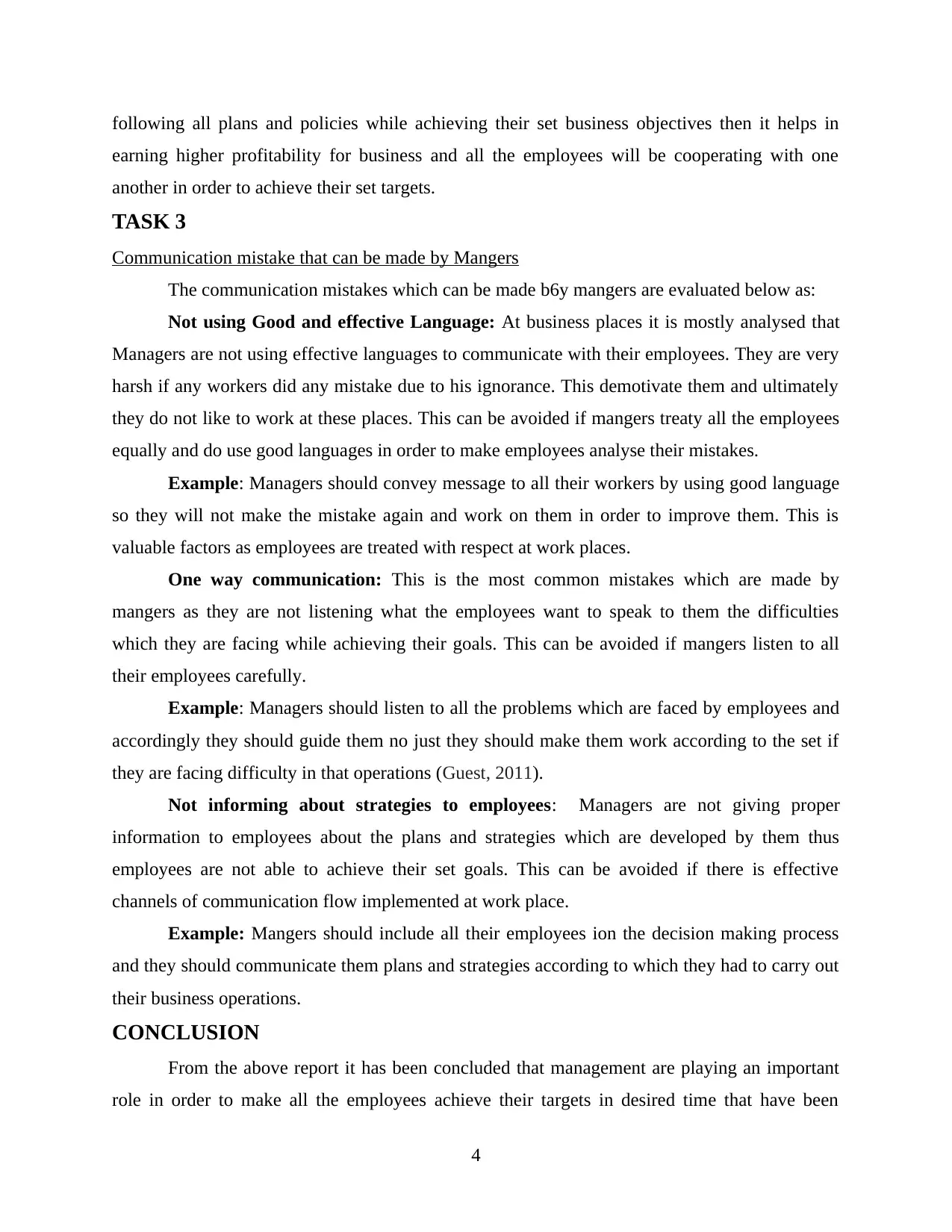
following all plans and policies while achieving their set business objectives then it helps in
earning higher profitability for business and all the employees will be cooperating with one
another in order to achieve their set targets.
TASK 3
Communication mistake that can be made by Mangers
The communication mistakes which can be made b6y mangers are evaluated below as:
Not using Good and effective Language: At business places it is mostly analysed that
Managers are not using effective languages to communicate with their employees. They are very
harsh if any workers did any mistake due to his ignorance. This demotivate them and ultimately
they do not like to work at these places. This can be avoided if mangers treaty all the employees
equally and do use good languages in order to make employees analyse their mistakes.
Example: Managers should convey message to all their workers by using good language
so they will not make the mistake again and work on them in order to improve them. This is
valuable factors as employees are treated with respect at work places.
One way communication: This is the most common mistakes which are made by
mangers as they are not listening what the employees want to speak to them the difficulties
which they are facing while achieving their goals. This can be avoided if mangers listen to all
their employees carefully.
Example: Managers should listen to all the problems which are faced by employees and
accordingly they should guide them no just they should make them work according to the set if
they are facing difficulty in that operations (Guest, 2011).
Not informing about strategies to employees: Managers are not giving proper
information to employees about the plans and strategies which are developed by them thus
employees are not able to achieve their set goals. This can be avoided if there is effective
channels of communication flow implemented at work place.
Example: Mangers should include all their employees ion the decision making process
and they should communicate them plans and strategies according to which they had to carry out
their business operations.
CONCLUSION
From the above report it has been concluded that management are playing an important
role in order to make all the employees achieve their targets in desired time that have been
4
earning higher profitability for business and all the employees will be cooperating with one
another in order to achieve their set targets.
TASK 3
Communication mistake that can be made by Mangers
The communication mistakes which can be made b6y mangers are evaluated below as:
Not using Good and effective Language: At business places it is mostly analysed that
Managers are not using effective languages to communicate with their employees. They are very
harsh if any workers did any mistake due to his ignorance. This demotivate them and ultimately
they do not like to work at these places. This can be avoided if mangers treaty all the employees
equally and do use good languages in order to make employees analyse their mistakes.
Example: Managers should convey message to all their workers by using good language
so they will not make the mistake again and work on them in order to improve them. This is
valuable factors as employees are treated with respect at work places.
One way communication: This is the most common mistakes which are made by
mangers as they are not listening what the employees want to speak to them the difficulties
which they are facing while achieving their goals. This can be avoided if mangers listen to all
their employees carefully.
Example: Managers should listen to all the problems which are faced by employees and
accordingly they should guide them no just they should make them work according to the set if
they are facing difficulty in that operations (Guest, 2011).
Not informing about strategies to employees: Managers are not giving proper
information to employees about the plans and strategies which are developed by them thus
employees are not able to achieve their set goals. This can be avoided if there is effective
channels of communication flow implemented at work place.
Example: Mangers should include all their employees ion the decision making process
and they should communicate them plans and strategies according to which they had to carry out
their business operations.
CONCLUSION
From the above report it has been concluded that management are playing an important
role in order to make all the employees achieve their targets in desired time that have been
4
⊘ This is a preview!⊘
Do you want full access?
Subscribe today to unlock all pages.

Trusted by 1+ million students worldwide
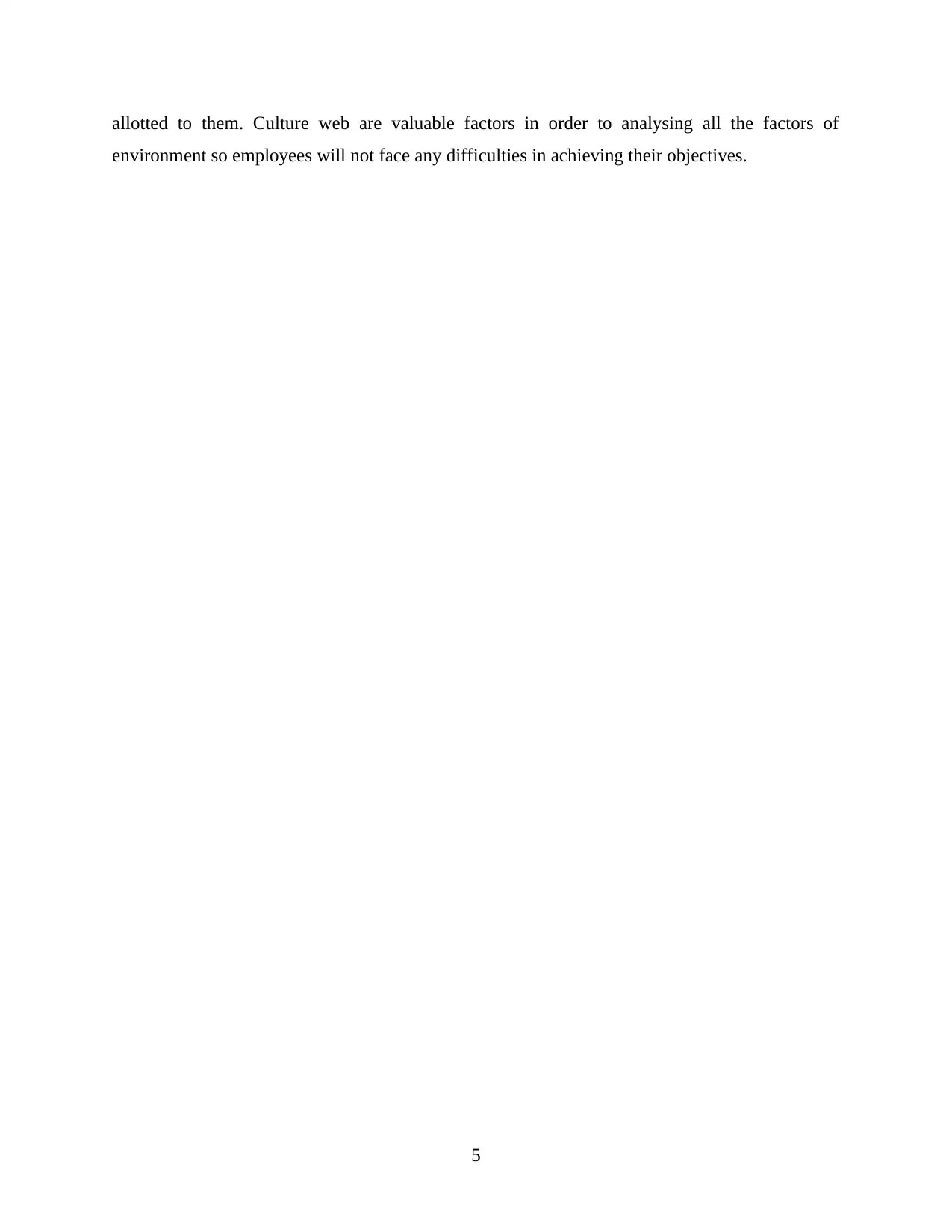
allotted to them. Culture web are valuable factors in order to analysing all the factors of
environment so employees will not face any difficulties in achieving their objectives.
5
environment so employees will not face any difficulties in achieving their objectives.
5
Paraphrase This Document
Need a fresh take? Get an instant paraphrase of this document with our AI Paraphraser
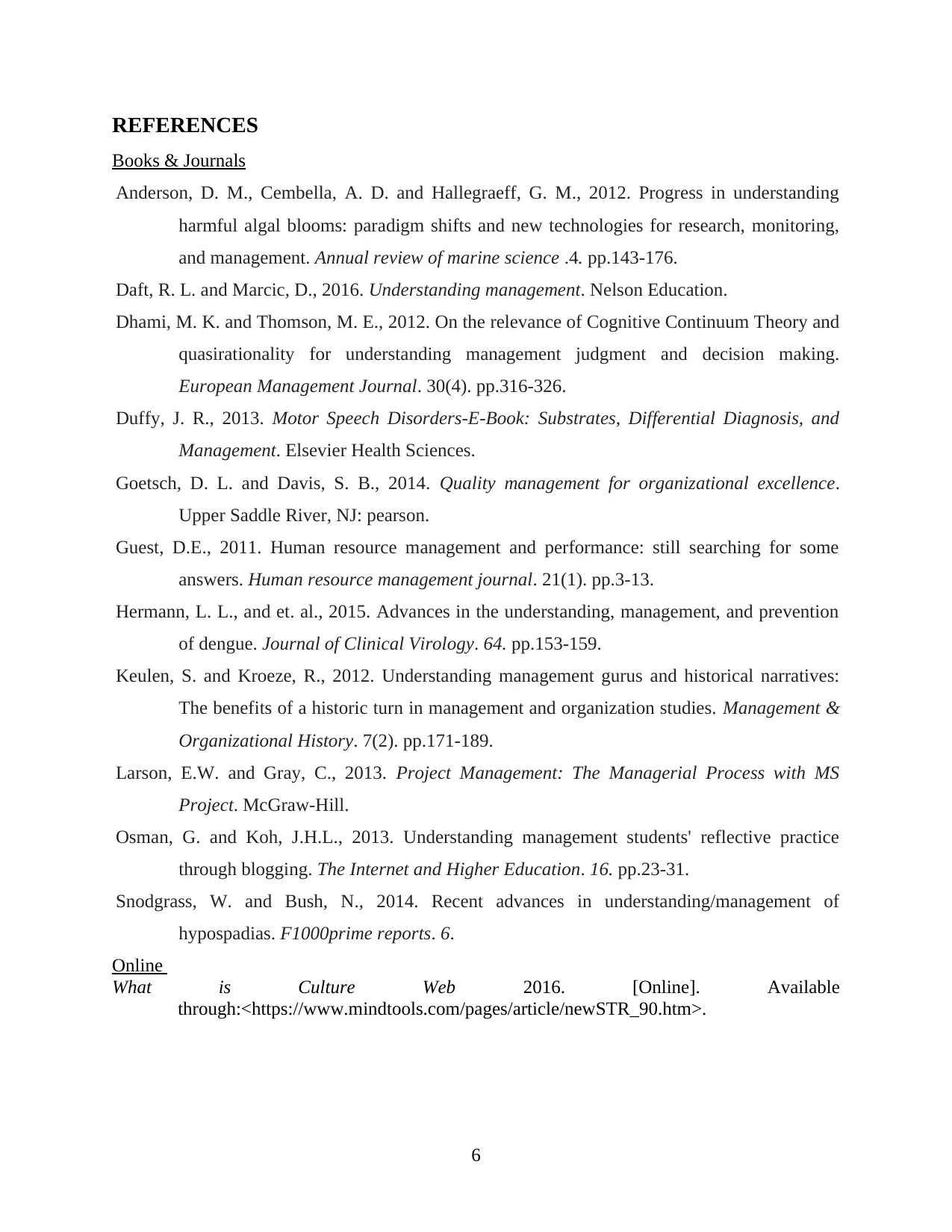
REFERENCES
Books & Journals
Anderson, D. M., Cembella, A. D. and Hallegraeff, G. M., 2012. Progress in understanding
harmful algal blooms: paradigm shifts and new technologies for research, monitoring,
and management. Annual review of marine science .4. pp.143-176.
Daft, R. L. and Marcic, D., 2016. Understanding management. Nelson Education.
Dhami, M. K. and Thomson, M. E., 2012. On the relevance of Cognitive Continuum Theory and
quasirationality for understanding management judgment and decision making.
European Management Journal. 30(4). pp.316-326.
Duffy, J. R., 2013. Motor Speech Disorders-E-Book: Substrates, Differential Diagnosis, and
Management. Elsevier Health Sciences.
Goetsch, D. L. and Davis, S. B., 2014. Quality management for organizational excellence.
Upper Saddle River, NJ: pearson.
Guest, D.E., 2011. Human resource management and performance: still searching for some
answers. Human resource management journal. 21(1). pp.3-13.
Hermann, L. L., and et. al., 2015. Advances in the understanding, management, and prevention
of dengue. Journal of Clinical Virology. 64. pp.153-159.
Keulen, S. and Kroeze, R., 2012. Understanding management gurus and historical narratives:
The benefits of a historic turn in management and organization studies. Management &
Organizational History. 7(2). pp.171-189.
Larson, E.W. and Gray, C., 2013. Project Management: The Managerial Process with MS
Project. McGraw-Hill.
Osman, G. and Koh, J.H.L., 2013. Understanding management students' reflective practice
through blogging. The Internet and Higher Education. 16. pp.23-31.
Snodgrass, W. and Bush, N., 2014. Recent advances in understanding/management of
hypospadias. F1000prime reports. 6.
Online
What is Culture Web 2016. [Online]. Available
through:<https://www.mindtools.com/pages/article/newSTR_90.htm>.
6
Books & Journals
Anderson, D. M., Cembella, A. D. and Hallegraeff, G. M., 2012. Progress in understanding
harmful algal blooms: paradigm shifts and new technologies for research, monitoring,
and management. Annual review of marine science .4. pp.143-176.
Daft, R. L. and Marcic, D., 2016. Understanding management. Nelson Education.
Dhami, M. K. and Thomson, M. E., 2012. On the relevance of Cognitive Continuum Theory and
quasirationality for understanding management judgment and decision making.
European Management Journal. 30(4). pp.316-326.
Duffy, J. R., 2013. Motor Speech Disorders-E-Book: Substrates, Differential Diagnosis, and
Management. Elsevier Health Sciences.
Goetsch, D. L. and Davis, S. B., 2014. Quality management for organizational excellence.
Upper Saddle River, NJ: pearson.
Guest, D.E., 2011. Human resource management and performance: still searching for some
answers. Human resource management journal. 21(1). pp.3-13.
Hermann, L. L., and et. al., 2015. Advances in the understanding, management, and prevention
of dengue. Journal of Clinical Virology. 64. pp.153-159.
Keulen, S. and Kroeze, R., 2012. Understanding management gurus and historical narratives:
The benefits of a historic turn in management and organization studies. Management &
Organizational History. 7(2). pp.171-189.
Larson, E.W. and Gray, C., 2013. Project Management: The Managerial Process with MS
Project. McGraw-Hill.
Osman, G. and Koh, J.H.L., 2013. Understanding management students' reflective practice
through blogging. The Internet and Higher Education. 16. pp.23-31.
Snodgrass, W. and Bush, N., 2014. Recent advances in understanding/management of
hypospadias. F1000prime reports. 6.
Online
What is Culture Web 2016. [Online]. Available
through:<https://www.mindtools.com/pages/article/newSTR_90.htm>.
6

7
⊘ This is a preview!⊘
Do you want full access?
Subscribe today to unlock all pages.

Trusted by 1+ million students worldwide
1 out of 9
Related Documents
Your All-in-One AI-Powered Toolkit for Academic Success.
+13062052269
info@desklib.com
Available 24*7 on WhatsApp / Email
![[object Object]](/_next/static/media/star-bottom.7253800d.svg)
Unlock your academic potential
Copyright © 2020–2025 A2Z Services. All Rights Reserved. Developed and managed by ZUCOL.




